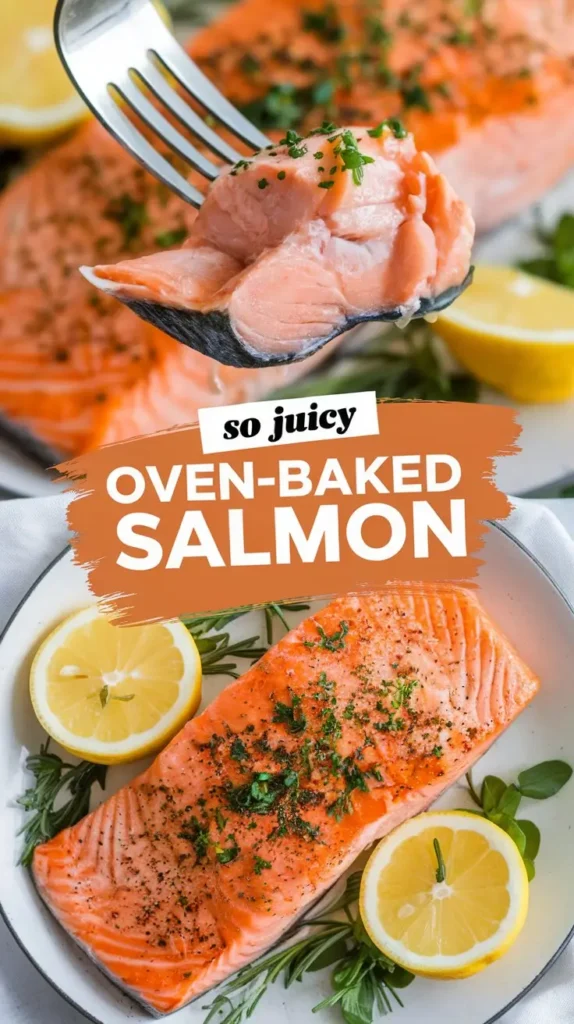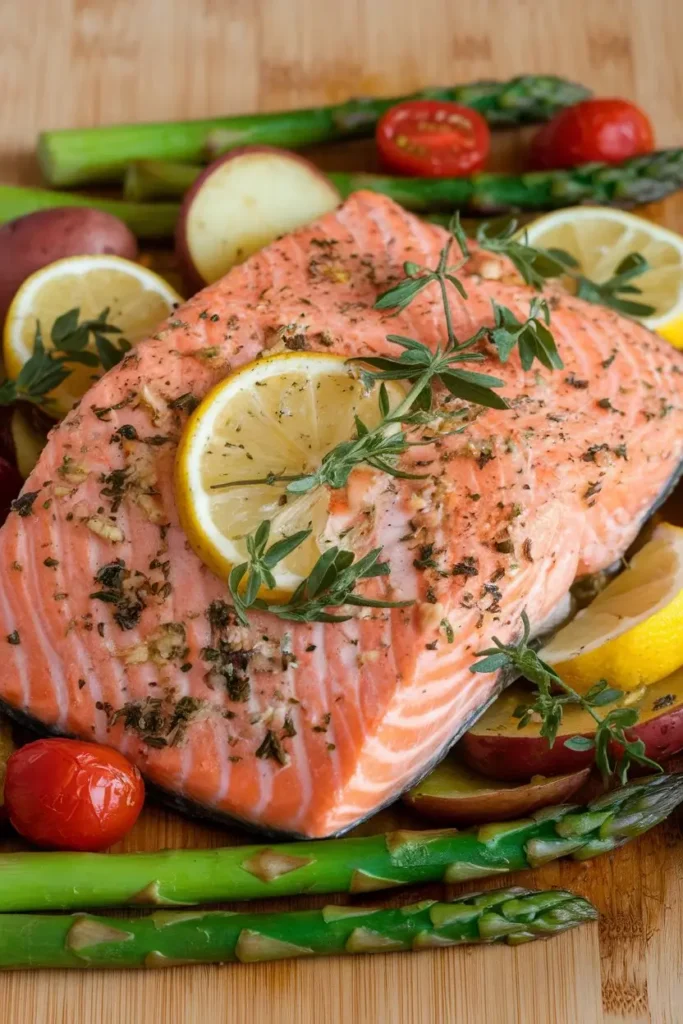If the USDA calls 145 F safe while most chefs aim for 125 to 130 F, which target will actually give you tender, flaky oven-baked salmon on a weeknight? The answer is a mix of food science and technique, and it’s easier than most people think. With a few smart steps, oven-baked salmon can be juicy, aromatic, and perfectly cooked every time.
The Science and Soul of Oven-Baked Salmon
Introduction
Home cooks often hear conflicting advice. Salt early or right before cooking? Skin on or off? Parchment, foil, or a bare sheet pan? Let’s clear it up with a simple, reliable method rooted in temperature control and moisture management. This guide focuses on oven-baked salmon as a stress-free centerpiece that works for busy nights and dinner parties alike.
Here’s the short version: season, roast hot, use a thermometer, and rest. Your fillets will flake easily, glisten with natural juices, and taste clean and bright.
Ingredients List
This recipe serves 4.
- 4 salmon fillets, skin-on, 6 ounces each, about 1 inch thick
- 1.25 teaspoons kosher salt, divided
- 0.5 teaspoon freshly ground black pepper
- 2 tablespoons extra-virgin olive oil
- 1 large lemon, zested and cut into wedges
- 2 garlic cloves, very finely minced or grated
- 2 tablespoons chopped fresh dill or parsley
- Optional sweet-tangy finish: 2 teaspoons honey + 2 teaspoons Dijon mustard
- Optional savory umami glaze: 2 teaspoons white miso + 2 teaspoons low-sodium soy sauce + 1 teaspoon rice vinegar
Sensory bonus:
- A final drizzle of good olive oil and a sprinkle of flaky salt right before serving wakes up every bite.
- Lemon zest mixed into oil and garlic perfumes the fish without overpowering it.
Substitutions and swaps:
- No fresh dill? Use chives, tarragon, or basil.
- Extra-virgin olive oil can be swapped for avocado oil or melted ghee.
- For spice fans, add 0.5 teaspoon smoked paprika or a pinch of red pepper flakes.
- Low-sodium needs? Cut added salt by one third and use the miso-soy glaze sparingly.
- Dairy-free and gluten-free friendly by default. For gluten-free soy, choose tamari or coconut aminos.
Timing
- Prep time: 10 minutes
- Cook time: 12 to 15 minutes at 400 to 425 F for 1-inch-thick fillets
- Rest: 3 minutes
- Total: 25 to 30 minutes
That total is roughly 30 percent quicker than many marinade-heavy salmon recipes, and you still get deep flavor thanks to lemon zest, garlic, and a short rest that redistributes juices.
Time by thickness and oven temperature:
- 0.75 inch: 8 to 10 minutes at 425 F, 10 to 12 minutes at 400 F
- 1.0 inch: 10 to 12 minutes at 425 F, 12 to 14 minutes at 400 F
- 1.25 inch: 12 to 14 minutes at 425 F, 14 to 16 minutes at 400 F
Target temperature and texture guide:
- 120 to 125 F in the center for moist, translucent-medium
- 125 to 130 F for medium
- 130 to 135 F for medium-well with minimal translucency
USDA guidance lists 145 F for safety. Many cooks stop at 125 to 130 F and rely on a 3-minute rest, which nudges carryover heat upward while preserving juiciness. Choose the number that fits your comfort and texture preference.
Quick recap in 50 words
Season early, roast hot at 400 to 425 F, and pull salmon at 125 to 130 F for moist results. Use a preheated pan, pat fillets dry, and avoid overcrowding. Rest for 3 minutes, then finish with lemon and herbs. This approach delivers flavorful, flaky oven-baked salmon in under 30 minutes.

Step-by-Step Instructions
Step 1: Preheat for success
- Place a rimmed sheet pan on the middle rack and preheat the oven to 425 F. A hot pan helps the skin render and prevents sticking.
- If using parchment, you can skip preheating the pan, but still get the oven fully hot.
Pro tip: Ovens often run cool or hot. A $15 oven thermometer can correct 10 to 25 F swings.
Step 2: Pat dry and dry-brine
- Pat the salmon thoroughly with paper towels.
- Season with 1 teaspoon kosher salt and the pepper, aiming for even coverage. Let it sit at room temperature for 10 to 20 minutes. This short dry-brine seasons the flesh and helps surface moisture evaporate.
Step 3: Flavor the surface
- In a small bowl, mix olive oil, lemon zest, and garlic. Brush or spoon the mixture over the top of the fillets.
- If using the honey-mustard or miso-soy option, wait to apply until the last 2 to 3 minutes of roasting. Sugar and miso brown quickly and can darken too fast if applied at the start.
Step 4: Pan setup
- For a preheated sheet pan: lightly oil it right before the fish goes on. Use a high-smoke-point oil if you have it.
- For parchment: line a room-temperature sheet pan and spray or brush lightly with oil.
Place fillets skin-side down, leaving space between pieces for even air flow.
Step 5: Roast to temperature, not time
- Roast 10 to 12 minutes for 1-inch fillets at 425 F.
- Check the center with an instant-read thermometer. Aim for 125 to 130 F for medium. If you like it more translucent, stop at 120 to 125 F.
- Apply optional glaze during the last 2 to 3 minutes, then return to the oven.
No thermometer today?
- Look for flakes that separate with a gentle press and a center that’s just turning opaque.
Step 6: Optional broil for color
- For more browning on top, switch to broil for 60 to 90 seconds at the end. Watch closely. A quick broil adds light caramelization without drying the fish.
Step 7: Rest and finish
- Rest salmon for 3 minutes to let juices settle.
- Squeeze fresh lemon over the top, add dill or parsley, and finish with a small drizzle of oil and flaky salt.
Nutritional Information
Values per serving, based on one 6-ounce fillet, 0.5 tablespoon olive oil, lemon, and seasonings.
| Nutrient | Amount |
|---|---|
| Calories | ~330 |
| Protein | ~34 g |
| Total Fat | ~19 g |
| Saturated Fat | ~3 g |
| Omega-3s (EPA+DHA) | ~1.5 to 2.0 g |
| Carbohydrates | ~3 g |
| Fiber | 0 g |
| Total Sugars | ~2 g |
| Sodium | ~300 to 400 mg |
| Vitamin D | ~400 to 600 IU |
| Selenium | ~40 to 50 mcg |
Notes:
- Atlantic farmed salmon trends higher in fat and calories, wild sockeye lower. Both provide high-quality protein and omega-3s that support heart and brain health.
- Sodium varies with salt type and glaze.
Healthier Alternatives for the Recipe
- Lower sodium: Cut added salt to 0.75 teaspoon and use citrus and herbs to amplify flavor. Choose low-sodium tamari if using the miso-soy glaze.
- Lower fat: Reduce oil to 1 tablespoon total. The fish’s natural oils carry flavor well.
- No added sugar: Skip honey and sweet glazes. A bright salsa of chopped cucumber, lemon, and dill adds freshness without sugar.
- Dairy-free creamy finish: Whisk tahini, lemon juice, and warm water with a pinch of salt for a silky, dairy-free sauce.
- High-protein crunch: Sprinkle a light panko-herb topping mixed with a teaspoon of oil. Toast under broil for 30 to 45 seconds at the end. Use gluten-free panko if needed.
- Paleo and Whole30: Keep it simple with olive oil, lemon, garlic, dill, salt, and pepper.
Serving Suggestions
Turn oven-baked salmon into an adaptable plate that fits any table:
- Citrus-fennel salad with olive oil and capers
- Roasted asparagus or broccolini on the same sheet pan in the final 10 minutes
- Quinoa with herbs and pistachios
- Brown rice with scallions and sesame seeds
- Cauliflower mash with chives for a light, creamy side
- Cucumber, avocado, and tomato salad with red wine vinegar
For sauce lovers:
- Bright: Lemon-dill yogurt, or a dairy-free tahini-lemon drizzle
- Savory: Miso-ginger sauce with a hint of rice vinegar
- Herbaceous: Salsa verde with parsley, anchovy, and lemon zest
Wine pairing:
- Crisp white like Sauvignon Blanc for citrus-forward plates
- Pinot Noir for richer, fattier salmon, especially if you use a miso-soy glaze
Common Mistakes to Avoid
- Overcooking: Pull at 125 to 130 F for medium, then rest. Carryover heat finishes the job.
- Skipping the pat-dry step: Water on the surface steams the fish and blocks browning.
- Cold fish straight from the fridge: A quick 10 to 20 minute rest at room temp improves even cooking.
- Neglecting oven preheat: A fully hot oven builds momentum for tender texture and better browning.
- Overcrowding the pan: Space between fillets matters for air circulation and even roasting.
- Applying sugary glaze too early: Add with 2 to 3 minutes left to prevent burnt spots.
- Peeking too often: Every door open drops oven temp. Check once near the earliest time.
- No thermometer: Guessing leads to dry fish. A tiny instant-read tool is a big upgrade.
Storing Tips for the Recipe
- Refrigeration: Store cooked salmon in a covered container for up to 3 to 4 days.
- Freezing: Wrap tightly and freeze for up to 2 to 3 months. Thaw overnight in the fridge for best texture.
- Reheating: Warm gently at 275 F for 10 to 12 minutes, or flake cold salmon over salads, grain bowls, or avocado toast. Avoid microwaving on high power, which can toughen the edges.
- Meal-prep moves: Mix your oil, lemon zest, and garlic a day ahead. You can also portion and salt the fillets 30 minutes prior to roasting for a quick dry-brine when you walk in the door.
FAQs
What oven temperature is best for oven-baked salmon?
A hot oven helps. Use 425 F for crisp edges and juicy centers on 1-inch fillets. For thicker cuts, 400 F gives you a wider window before overcooking.
Should I cook salmon with the skin on?
Yes. Skin acts like a built-in shield, protects the delicate flesh, and makes handling easier. After roasting, the flesh often releases easily from the skin if you prefer not to eat it.
How do I know when salmon is done without a thermometer?
Press the top gently. It should flake under light pressure and the center should just turn opaque. If it looks very glossy and resists flaking, give it another minute, then check again.
Can I bake frozen salmon?
You can, but the texture is better when thawed. If baking from frozen, go 400 F for 18 to 25 minutes depending on thickness. Season generously and add glaze near the end.
What’s the ideal internal temperature for safety and taste?
USDA lists 145 F as safe. Many pros target 125 to 130 F for medium, then rest 3 minutes. If you prefer more doneness, aim 130 to 135 F.
Which salmon should I buy: wild or farmed?
Both can be excellent. Wild sockeye is leaner and more robust in flavor. Farmed Atlantic tends to be richer and more forgiving. Look for firm flesh, bright color, and a clean ocean scent.
Is parchment better than foil?
Parchment reduces sticking and encourages gentle roasting. Foil makes cleanup easy and traps steam, which can soften the skin. For crisp skin, use a preheated bare pan with a light oil film.
Can I add vegetables on the same pan?
Yes, just stagger timing. Start dense veggies first. Add salmon for the final 12 to 15 minutes so everything finishes together.
What if my fillet is very thick in the center?
Lower the oven to 400 F and add a few minutes. Check temperature early and often near the center to hit your preferred doneness.
Ready to cook? Try this method tonight, then share your results in the comments and leave a star rating. If you enjoy smart, data-driven kitchen wins, subscribe for fresh recipes and cooking guides tailored to your goals.


